by Guest Writer
No matter what season it is, patios are an essential part of any outdoor setup. Design a great one for a sunny day with the kids, or for relaxing with friends by a fire pit. Here are 5 beautiful patios to draw inspiration from.
1. ALL INCLUSIVE IN BRICK
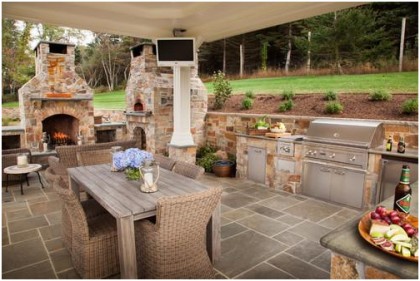
Via Houzz
Laid out in beautiful brick and stone work, this patio really has it all. It’s the perfect place for to hold that Labor Day barbecue or celebrate your favorite team’s latest victory. The layout of the grill, oven, and counter tops make this a streamline system for cooking food for the masses. Plus in the winter, you can cozy up in front of the fire to warm up between playing in the snow.
2. A LOVELY GARDEN
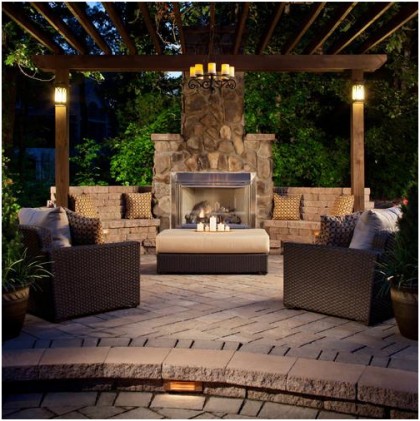
Via Houzz
Bring on the romance with beautiful trailing vines which give an open air effect while still providing shade and privacy. The fireplace becomes the central point with the seating curling around it, making it a cozy and intimate setting. Mix up the textures by bringing in some wicker furniture.
3. SUMMER DAYS
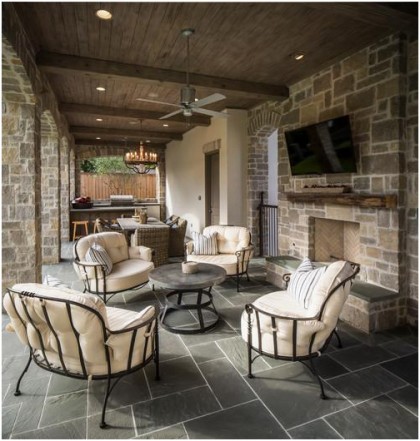
Via Houzz
For the dog days of summer, a ceiling fan comes in handy in this cool patio. It’s the perfect place to sip lemonade or as the bar off to the side implies, margaritas. With both a dining and a lounge side, this patio functions as a great outdoor dining room as well as a cool place to hang out in front of the TV in those ultra plush chairs. The stone next to the wood gives it a stylish contemporary look while keeping it classic.
4. SMOOTH AND SLEEK AND CONTEMPORARY
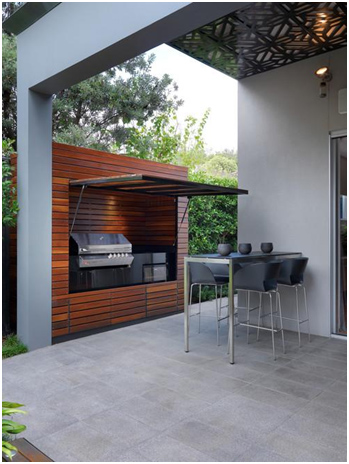
Via Houzz
With the smooth lines that make up the core of mid-century style, this patio is stunningly awesome. The wood panel housing for the grill is genius, not only does it provide a shield for your grill from the elements, but it also provides shade while you stand over it to slow cook your pork chops to perfection. Another really great touch is the lattice designs on the on the ceiling which adds a sense of artistry with the rest of the furnishings being solids.
5. PERFECT PARTY PATIO
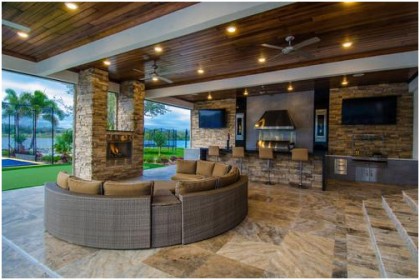
Via Houzz
Think of this not only as a patio, but also as an extension to your kitchen. This is the perfect space to host a cookout. Serve up your favorite recipe from behind a bar with no concerns about people getting in the way. Enjoy some great lighting that bounces beautifully off the polished marble floor. There’s the plus of having a fireplace for people to gather around to roast marshmallows or TVs to catch the game, all while having the ability to cook without being shut away in the kitchen.
This is a guest post by Tim Smith of Modernize.com. For more inspiration on designs for your backyard, check out Modernize.com.
Related Posts:
by Todd Rutherford
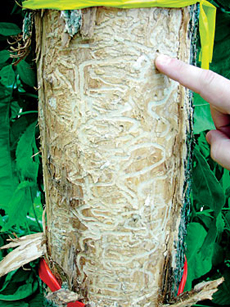
Green Ash tree killed by Emerald Ash Borer
2013 brought tragic news to urban tree enthusiasts in Colorado. In September 2013 the emerald ash borer was found in Boulder County. This find means that thousands of trees along Colorado’s Front Range could be decimated by this pest. And as Colorado State University Professor of Entomology Whitney Cranshaw tells us, the spread of the emerald ash borer (EAB) is dependent upon human activity. It is likely that EAB came to the United States via humans transporting contaminated wood crates from Asia, and it probably reached Colorado through contaminated firewood.
The emerald ash borer, Agrilus planipennis, is a beetle native to Asia. It is small, about the size of a grain of rice. Being a non-native insect in North America, it has no predators to keep its population in check. And unlike the Ash trees in Asia, our native Ash trees don’t possess the natural insecticides that control EAB. Adult borers eat leaves of Ash trees, then mate and lay eggs in crevices in the bark. The eggs hatch, releasing larvae which burrow beneath the bark, which disrupts the trees nutrient and water supplying layers. The tree becomes riddled with tunnels the larvae leave behind. The larvae then hatch in spring, burrowing their way to the surface, where they repeat the cycle of feeding on the leaves, breeding and laying eggs of new generation. They kill the canopy of the tree, limb by limb, with the entire tree dead in 3-5 years.
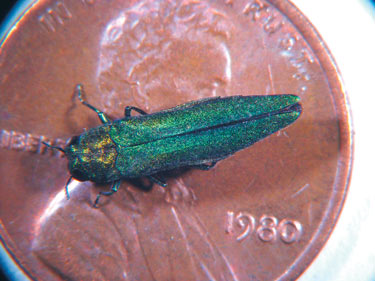
Adult EAB on a penny.
Colorado’s department of Agriculture estimates that there are 1.45 million ash trees in just the Denver Metro area alone. The costs to spray so many trees will quickly mount.
Tree and insect experts agree that there is no point in spraying your Ash tree unless the tree is currently infested. “Since most EAB treatments provide control for one year or, at most, two years following application there is no benefit in treating a tree prior to when EAB is present”, Cranshaw writes in a recent report from Colorado State University.
In other words there is no treatment that will stop the EAB from attacking your Ash tree. Spraying before the tree is infested only wastes money and needlessly adds dangerous chemicals to the environment. In fact, many entomologists warn that even spraying an infested tree may have lethal impacts on beneficial insects such as bees and butterflies, and won’t completely rid your tree of EAB, and would probably only buy you a few extra years of life of an infested Ash tree.
If we take a serious look at the situation, spraying at all is mostly a futile and dangerous endeavor. Spraying gives tree care companies extra income but endangers the life of beneficial insects, could possibly have harmful effects on people and is very unlikely to ultimately save your Ash tree. As CSU’s Cranshaw has said, he expects in 5-10 years all Ash trees in the Metro Denver area to be infested by EAB. Furthermore, Cranshaw writes: “Once established at a location emerald ash borer can be expected to survive in the area as long as any ash trees remain. Therefore some management of emerald ash borer will be required for as long as one wishes to maintain the tree”. It is our opinion that a better strategy to dealing with EAB is planning for the eventual replacement of your Ash tree, rather than treating your ash tree with toxic chemicals, year after year.
What can we do to slow the spread of EAB to the rest of Colorado?
1.) Do not transport any ash wood in or out of your area.
2.) Do not plant more Ash trees in Colorado.
If you have an Ash tree, you really should consider planting a replacement tree now. If you are unsure about what type of tree would be a good alternative to Ash, contact your local nursery, arborist, or contact us and we can help you with that decision.
This is the official blog of Outdoor Design Group, Colorado Landscape Architects. For more information about our business and our services, click here.
Related Posts:
by Matt Corrion
1) Ditch the bluegrass turf lawn, completely or partially. Bluegrass turf uses far more water than alternative landscaping choices.
2) Set your mower on its highest setting so turf grass is not cut too short. Longer grass keeps the soil cooler and reduces evaporation.
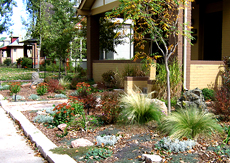
Consider redesigning your landscape so it requires less water and looks more interesting
3) Use the mulch setting on your lawn mower so grass clippings stay on the lawn, which helps slow evapotranspiration and provides nutrients to the soil.
4) Do not install bluegrass turf on slopes, especially south facing slopes, because much of the water will run off the slope and sprinklers will need to run for longer times to compensate. Instead consider planting shrubs or native plants with drip irrigation on a slope.
5) Mulch your trees, shrubs and perennials to reduce water use. Mulch slows down the evaporation of soil moisture, reduces water run-off, and reduces weeds which can steal moisture from your plants.
6) Consider replacing your existing high-water turf lawn with low-water turf options such as buffalo grass, blue grama grass or a fescue grass.
7) Plant native plants that are more appropriate for the climate you live in.
8) If you plant non-native plants, use ones that are adapted to your climate conditions, such as iceplant from South Africa, and Russian sage from Central Asia.
9) Place your plants in groups organized by water use, so as to avoid overwatering low water need plants.
10) Plant trees in your turf lawn to provide shade for the lawn and reduce evapotranspiration of the grass.
11) Follow your water provider’s summer watering rules, and any watering restrictions that may be in place at that time.
12) Don’t water during the hottest time of the day. It is best to water between 6 pm and 10 am. Watering during the hottest time of the day increases the evaporation of the water before it reaches the roots of your plants.
13) Don’t water when it is windy. Just as watering during the hottest time of day increases water loss due to increased evaporation, so does watering when it is windy.
14) When shoveling snow in winter, place snow piles where it will melt and water trees and shrubs that can benefit from extra moisture in winter.
15) Install a rain sensor to avoid having your irrigation system run when it is raining, or the day after a heavy rainfall event.
16) If you don’t have an automatic irrigation system, use a mechanical or digital timer with your sprinklers.
17) If you have an automatic irrigation system, check it once a month or more often to fix any leaks or problems that may occur.
18) Use drip irrigation to water your landscape plants. Drip irrigation is the most efficient form of irrigation because the water is not sprayed into the air which increases evaporation of the water before it reaches the plants.
19) Avoid placing sprinkler heads against fences and hardscape. Instead, install a strip of rock mulch between fences / hardscape and sprinkler heads. In addition to reducing water waste, this minimizes water damage and the need for turf edge trimming.
20) Improve your soils water holding capacity by amending the soil with organic matter.
21) Make your landscape more permeable to keep storm water on your property. Instead of a solid concrete patio, install a unit paver patio to allow water to percolate down rather than running off.
22) Divide watering times into shorter shifts to improve water absorption, and avoid runoff. This is sometimes referred to as the “cycle and soak” method.
23) Direct gutter downspouts to planted areas rather than streets or storm water areas.
24) Save rainwater from your roof for irrigating plants.
25) Save indoor “grey” water for irrigating trees and shrubs.
26) If local codes allow, hire a plumber (or DIY) to pipe your grey water to your landscaping.
27) Use a mild/natural dish soap for washing dishes to keep this grey water safer for your landscape plants.
28) Bathe your pets outside over turf areas that need water, using mild/natural soap.
29) Wash fruits and vegetables outside over your lawn to allow wash water to irrigate the turf.
30) Plant trees (adapted for your climate) to shade your turf area to reduce evapo-transpiration of the turf.
31) Consult a landscape architect or horticulturalist to learn the best plants to use in your climate and growing zone.
32) Before planting certain species of plants, do extensive soil preparations. Some plants benefit from additional organic matter, while others will perform better if drainage is improved.
33) Save fallen leaves in autumn and use as a mulch around trees, shrubs and perennials.
34) Plant new perennials, shrubs and trees in fall when temperatures are cooler because it will take less water to establish them, as compared to planting in early summer.
35) Cover water features, pools and spas when not in use to reduce evaporation.
36) Check water features, pools and spas for leaks.
37) Consider using pondless water features, where the water reservoir is hidden or obscured which provides less evaporation that a typical pond.
38) Don’t use water to clean paving. Use a broom and dust pan.
39) If you want to install a water feature, choose one that cascades or trickles rather than one that sprays in the air. Spraying fountains lose more water to evaporation.
40) If your children want to play in the sprinkler, have them do this in an area of your lawn that needs water.
41) Do not let your children waste water by spraying sprinklers on sidewalks, drive ways or the street.
42) Place large rocks near shrubs, trees or perennials to keep the soil below the rock cool and moist.
43) When refreshing your pet’s water dish, don’t discard the old water in the sink, pour it on plants outside.
44) If you have ice or water left in a take-out cup, or in re-usable glasses, pour it on your landscape plants outside.
45) Don’t discard used ice and water from a cooler in the sink, but throw them outside on your plants.
46) If you wash your car at home with a hose, use a shut-off nozzle so water is not running in between soaping and rinsing the car.
47) Wash the car in a lawn area so that you water the grass at the same time. Use a mild/natural detergent when doing this.
48) Don’t use a hose to clean out your gutters. Consider using a leaf blower or a long handled rake specifically made for the job.
49) Replace old spray nozzles on your irrigation system with newer, more efficient rotary nozzles. They reduce runoff and evaporation. Your purchase and installation of these nozzles may make you eligible for rebates from your water provider. Contact them for more details.
50) Consider hiring a landscape architect to analyze your property and re-design it to require less water and maintenance.
This is the official blog of Outdoor Design Group, Colorado Landscape Architects. For more information about our business and our services, click here.
Related Posts:
by Matt Corrion
On March 15, 2012, facilities across the United States must comply with the revised ADA (Americans with Disabilities Act) design standards adopted in the 2010 Standards for Accessible  Design.
Design.
The 2010 Standards set minimum requirements for newly designed and constructed or altered State or local government facilities, public accommodations, and commercial facilities to be readily accessible to and usable by individuals with disabilities.
I have reviewed the new standards, and they are pretty extensive. Property owners and designers should be aware of some of the changes that will be required when constructing or altering a facility.
The provision requiring accessible means of entry/exit for swimming pools has gained a lot of attention. On March 15th, the US Attorney General signed an extension of 60 days for this particular provision, while also opening up a public comment period.
The swimming pool provision, along with other key new provisions, as taken from the ADA website, include:
2. Recreational Boating Facilities (Sections 235, 1003)
If boat slips are provided at a boating facility, the minimum number that must be accessible depends upon the size of the facility. Accessible boat slips must be dispersed throughout the various types of boat slips.
Where boarding piers are provided at boat launch ramps, at least 5% (but no fewer than one) must be accessible. Gangways that are part of a required accessible route are to be accessible, subject to certain enumerated exceptions.
4. Fishing Piers and Platforms (Sections 237, 1005)
Newly designed, newly constructed, or altered fishing piers must provide accessible routes, subject to the same exceptions permitted for gangways. At least 25% of guardrails or handrails must be no higher than 34 inches and must be dispersed. Clear floor or ground space must be provided at each accessible railing, and turning space must be provided on the pier.
5. Golf Facilities (Sections 238, 1006)
Newly constructed and altered golf facilities must have either an accessible route or golf car passages with a minimum width of 48 inches connecting accessible elements and spaces within the boundary of the golf course. An accessible route must be provided to the golf car rental area, bag drop-off areas, and other elements that are outside the boundary of the golf course. One or two teeing grounds (depending on the total number provided) per hole must be accessible.
If weather shelters are provided, a golf car must be able to enter and exit the shelters. Certain percentages of practice teeing grounds, practice teeing stations at driving ranges, and putting greens must be accessible.
6. Miniature Golf (Sections 239, 1007)
At least fifty percent of all holes on a miniature golf course must be accessible. These accessible holes must be consecutive, and they must be on an accessible route. The last accessible hole must be on an accessible route that connects to the course entrance or exit without going back through other holes.
7. Play Areas (Sections 240, 1008)
Play areas designed, constructed, and altered for children ages two and over in a variety of settings, including parks, schools, childcare facilities, and shopping centers, are covered.
Accessible ground and elevated play components, accessible routes, ramps and transfer systems (typically a platform or transfer steps), and accessible ground surfaces must be provided.
8. Swimming Pools, Wading Pools, and Spas (Sections 242, 1009)
Accessible means of entry/exit are required for swimming pools. Such accessible means of entry include a pool lift or sloped entry, and either a transfer wall, transfer system, or pool stairs. Wading pools must provide a sloped entry, and spas must provide a pool lift, transfer wall, or transfer system. Wave action pools, leisure rivers, and sand bottom pools where user access is limited to one area shall not be required to provide more than one accessible means of entry, either a pool lift, sloped entry, or a transfer system.
This is the official blog of Outdoor Design Group, Colorado Landscape Architects. For more information about our business and our services, click here.
Related Posts:









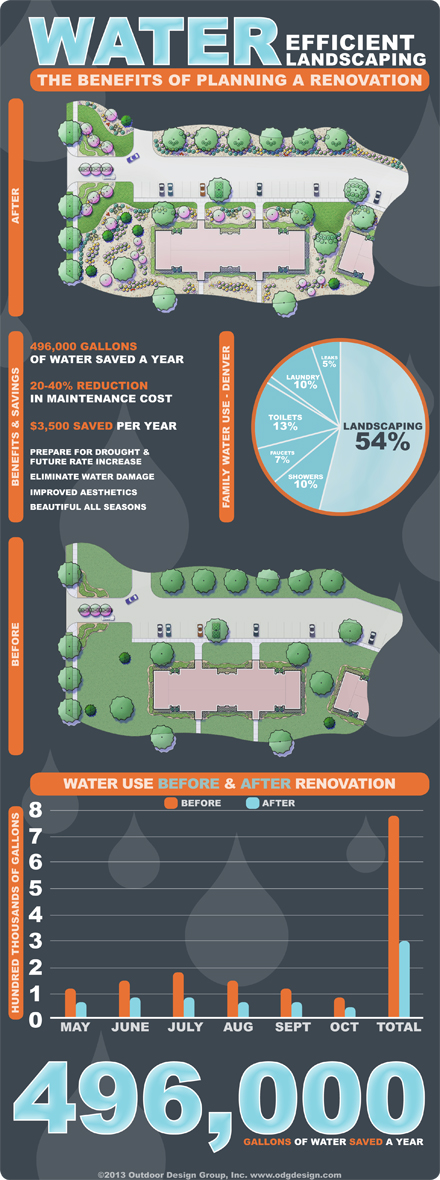
 Design.
Design.